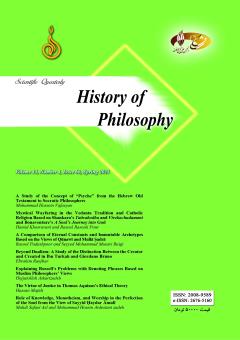About the journal
In order to expand and spread research in various fields of philosophy, history of philosophy, and comparative studies of philosophical schools, Scientific Society of History of Philosophy has recently published the first volume of the first specialized quarterly on the history of philosophy. The Journal of History of Philosophy publishes papers on the topics related to the history of philosophy, schools of philosophy, comparative studies, etymology of philosophical schools and theories, relationships among philosophical theories and contextual conditions, etc.
The people involved in the publication of the History of Philosophy Quarterly consist of the following
Permission holder: Scientific Society of History of Philosophy
Publisher: Sadra Islamic Philosophy Research Institute (SIPRIn)
Director: Professor Seyyed Mohammed Khamenei
Editor-in-chief: Hossein Kalbasi Ashtari, ‘Allameh Tabatabai’i University
-
Open Access Article
1 - Editor's Note
Hossein Kalbasi AshtariIssue 4 , Vol. 15 , Spring 2025 -
Open Access Article
2 - A Study of the Concept of “Psyche” from the Hebrew Old Testament to Socratic Philosophers
Mohammad Hossein Vafaiyan *Issue 4 , Vol. 15 , Spring 2025 -
Open Access Article
3 - Mystical Wayfaring in the Vedanta Tradition and Catholic Religion Based on Shankara’s Tattvabodha and Vivekachudamani and Bonaventure’s A Soul’s Journey into God
Hamid Khosravani * ، Rasoul RasoulipourIssue 4 , Vol. 15 , Spring 2025 -
Open Access Article
4 - A Comparison of Eternal Constants and Immutable Archetypes Based on the Views of Qūnawī and Mullā Ṣadrā
Rasool Padashpoor ، Seyyed Mohammad Musavi Baiagi *Issue 4 , Vol. 15 , Spring 2025 -
Open Access Article
5 - Beyond Dualism: A Study of the Distinction Between the Creator and Created in Ibn Turkah and Giordano Bruno
Ebrahim Ranjbar *Issue 4 , Vol. 15 , Spring 2025 -
Open Access Article
6 - Explaining Russell’s Problems with Denoting Phrases Based on Muslim Philosophers’ Views
Hojjatullah Askarizadeh *Issue 4 , Vol. 15 , Spring 2025 -
Open Access Article
7 - The Virtue of Justice in Thomas Aquinas’s Ethical Theory
Hassan Majidi *Issue 4 , Vol. 15 , Spring 2025 -
Open Access Article
8 - Role of Knowledge, Monotheism, and Worship in the Perfection of the Soul from the View of Sayyid Ḥaydar Āmulī
Mahdi Safaei Asl ، Mohammad Hosein Ardestanizadeh *Issue 4 , Vol. 15 , Spring 2025
-
Open Access Article
1 - A Critical Study of the Illuminationist Nature of Ibn Sina’s Philosophy
Abdolhossein Khosropanah ، Hesam al-Din Momeni Shahraki * ، Seyyed Hamid Forghani DehnawiIssue 3 , Vol. 8 , Winter 2018 -
Open Access Article
2 - Elements and Place of the Concept of Techne in Greek Ancient Philosophy with Reference to Heidegger’s View
Hassan Mehrnia * ، Hossein Latifi ، Mahdi ZakeriIssue 3 , Vol. 8 , Winter 2018 -
Open Access Article
3 - foreword
Hossein Kalbasi AshtariIssue 4 , Vol. 6 , Spring 2016 -
Open Access Article
4 - Meaning of Truth in the View of Muslim Philosophers with an Emphasis on Ibn Arabi’s Works
Mohsen Habibi * ، Mohammad Sadiq RezaeeIssue 4 , Vol. 6 , Spring 2016 -
Open Access Article
5 - Dramatic Conflict between Law and Justice in Plato’s Crito
Abdulrasul Hasanifar * ، Seyyed Mohsen AlavipourIssue 1 , Vol. 8 , Summer 2017 -
Open Access Article
6 - foreword
Hossein Kalbasi AshtariIssue 2 , Vol. 8 , Autumn 2017 -
Open Access Article
7 - Doxography Tradition of Ancient Greek Philosophers (with Reference to Hermann Diels’ View)
Hossein Kalbasi Ashtari * ، Behnaz Aqili DehkordiIssue 3 , Vol. 7 , Winter 2017 -
Open Access Article
8 - Place of Justice in Plato and Farabi’s Utopia
Hossein Kalbasi Ashtari ، Parviz Hajizadeh *Issue 1 , Vol. 5 , Summer 2014 -
Open Access Article
9 - The Relationship between Language and Reality in Plato: An Interpretation of Plato’s Cratylus in the Light of the Three Allegories in Republic
Hassan Fathi ، Aboubakr Soleymanpour *Issue 1 , Vol. 8 , Summer 2017 -
Open Access Article
10 - The Relationship between Gods and Man in Greek Philosophy
Abdulrasul Hasanifar * ، Sajjad ChitforushIssue 1 , Vol. 9 , Summer 2018






